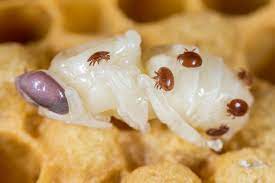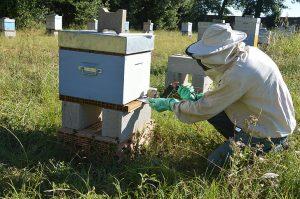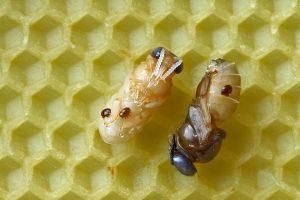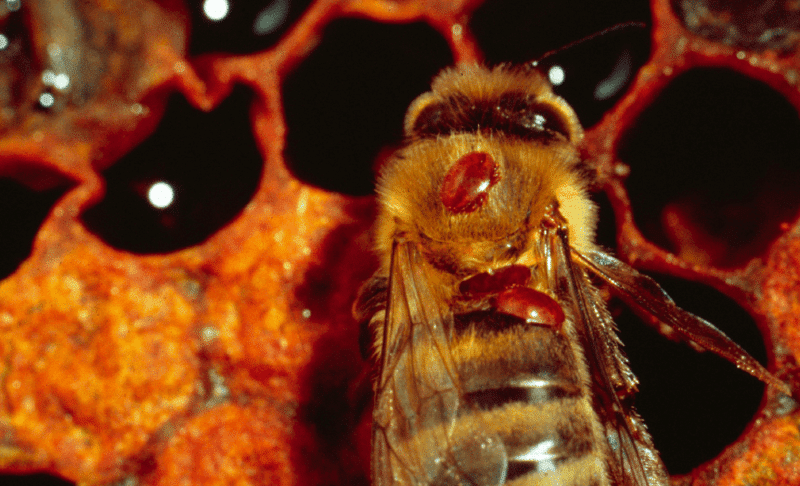Understanding the Impact of Varroa Mites and How Beekeepers Can Protect Their Colonies
The Varroa destructor mite is a parasitic mite that feeds on the hemolymph (the blood-like fluid) of honeybees. These mites are native to Asia and were introduced to the United States and Europe in the late 1980s, where they have caused significant damage to honey bee populations ever since.
The Varroa mite is one of the greatest threats to honey bee health and is responsible for the widespread colony losses seen in recent years. These mites are particularly dangerous because they not only weaken bees by feeding on their hemolymph, but they also transmit diseases such as Deformed Wing Virus (DWV), Acute Bee Paralysis Virus (ABPV), and Israeli Acute Paralysis Virus (IAPV).

Varroa mites reproduce by laying their eggs in developing bee brood cells, where they feed on the developing bees’ hemolymph. The mites then move on to other developing bees, where they continue to feed and reproduce. As the infestation grows, the mites weaken the bees, making them more susceptible to disease, and eventually, the colony may collapse.
One of the most significant challenges in controlling Varroa mite infestations is that these mites have developed resistance to many of the treatments used to control them. However, there are still several effective methods available to control Varroa mite infestations.
One of the most common treatments for Varroa mites is the use of chemical miticides. These products are designed to kill the mites but can also be harmful to the bees if not used correctly. Some beekeepers also use essential oils, such as thymol or eucalyptus, to control Varroa mites. These products are generally considered safer for the bees but may not be as effective as chemical miticides.
Another treatment method is the use of screened bottom boards, which allow mites to fall off the bees and out of the hive. This method does not kill the mites but can help to reduce the infestation level in the colony.
“Choosing the Right Method to Protect Your Bee Colonies and Promote Healthy Hives”
Chemical miticides are the most commonly used treatment for varroa mites. These are synthetic compounds that kill the mites by either contact or ingestion. Amitraz, fluvalinate, and coumaphos are some examples of chemical miticides. However, the use of chemical miticides can lead to mite resistance and may harm bees, especially if not used correctly. Therefore, beekeepers should follow the manufacturer’s guidelines and use them only when necessary.
Organic Acids

Organic acids are natural compounds that are used to treat varroa mites. Formic acid, oxalic acid, and acetic acid are some commonly used organic acids. These acids are applied directly to the hive, and the fumes kill the mites. Organic acids are considered safer than chemical miticides, but their efficacy can vary depending on the mite’s population size and environmental conditions.
Essential Oils
Essential oils, such as thymol and wintergreen, are natural compounds that are toxic to varroa mites. They are applied as a vapor or solution to the hive, and the bees disperse the oils throughout the hive, killing the mites. Essential oils are relatively safe for bees, but their effectiveness can vary depending on the concentration and application method.
Integrated Pest Management (IPM)

Integrated pest management (IPM) is a holistic approach to pest management that uses a combination of techniques to control varroa mites. IPM combines chemical treatments, organic acids, essential oils, and other methods, such as screen bottom boards, to reduce the mite population in the hive. IPM aims to minimize the use of chemicals and promote the health of the hive through natural means.
Mite-Resistant Bees
Mite-resistant bees are a newer approach to controlling varroa mites. These bees are bred to have genetic traits that make them more resistant to varroa mites. Some examples of mite-resistant bees are Russian bees and Minnesota hygienic bees. While this approach is promising, mite-resistant bees may not be available or suitable for all beekeepers.
In conclusion, controlling varroa mites is crucial to the health and survival of bee colonies. Chemical miticides, organic acids, essential oils, integrated pest management, and mite-resistant bees are all methods that beekeepers can use to treat varroa mites. It is essential to monitor the mite population and adjust the treatment method accordingly. Beekeepers should aim to use natural and sustainable methods to promote the health of the hive and minimize the use of chemicals.
